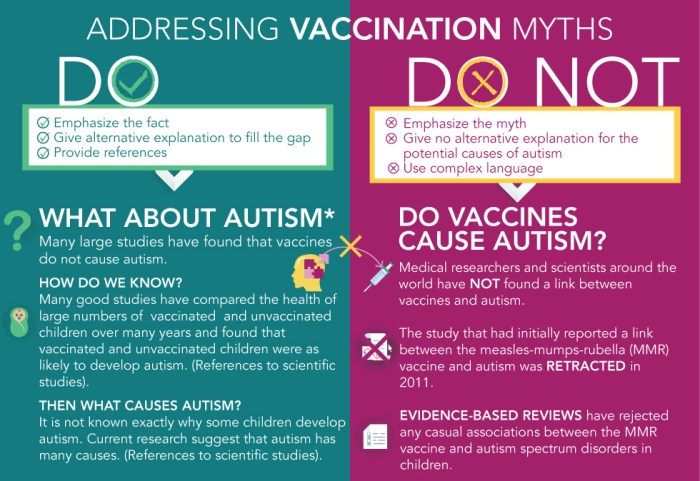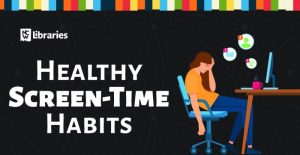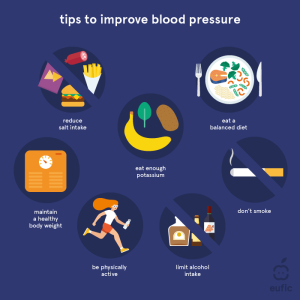
How to address vaccine misinformation and myths: Strategies and Solutions invites readers into the realm of combating false information surrounding vaccines, offering a glimpse into effective approaches and solutions to this pressing public health issue. As we delve deeper into this topic, we uncover the vital role of credible sources, community engagement, and the power of education in dispelling myths and promoting vaccine acceptance.
The discussion unfolds with a focus on understanding the roots of misinformation, exploring debunking strategies with facts and evidence, and examining the influence of social media and technology in shaping public perceptions. Through collaborative efforts and partnerships, we highlight success stories that illuminate the path towards a more informed and trusting community when it comes to vaccines.
Understanding Vaccine Misinformation and Myths

Vaccine misinformation and myths refer to false or misleading information about vaccines that circulate in society, often leading to misconceptions and fear regarding vaccination. This misinformation can range from inaccurate claims about vaccine ingredients to conspiracy theories about the intentions behind vaccination programs.Addressing misinformation about vaccines is crucial for public health as it can impact vaccination rates, leading to outbreaks of preventable diseases.
When individuals believe in myths about vaccines, they may choose not to vaccinate themselves or their children, putting not only themselves at risk but also the broader community.
Examples of Common Vaccine Myths
- One common myth is that vaccines cause autism, a claim that has been thoroughly debunked by scientific research. There is no credible evidence linking vaccines to autism.
- Another myth is that natural immunity is superior to vaccine-induced immunity. While natural immunity can provide protection, vaccines are a safe and effective way to prevent diseases without the risk of severe illness or complications.
- Some individuals believe that vaccines contain harmful substances, such as mercury or toxins, that can cause harm. In reality, vaccines undergo rigorous testing and are made with ingredients that are safe for use in the human body.
- There is a myth that vaccines are not necessary because certain diseases have been eradicated. However, these diseases can resurface if vaccination rates drop, as seen with recent outbreaks of measles and other vaccine-preventable illnesses.
Strategies to Address Vaccine Misinformation
The spread of vaccine misinformation poses a significant threat to public health, making it crucial to combat false claims with accurate information from credible sources. Utilizing strategies to address vaccine myths is essential in promoting vaccination and protecting communities from preventable diseases.
Using Credible Sources to Counter Vaccine Misinformation
It is vital to rely on reputable sources such as the Centers for Disease Control and Prevention (CDC), World Health Organization (WHO), and peer-reviewed scientific journals to debunk vaccine misinformation effectively. These sources provide evidence-based information that can help dispel myths and educate the public on the importance of vaccines.
Effective Communication of Accurate Vaccine Information, How to address vaccine misinformation and myths
- Utilize clear and simple language to explain the benefits of vaccines and address common misconceptions.
- Engage with the community through educational campaigns, social media, and public forums to disseminate accurate information.
- Encourage open dialogue and address concerns with empathy and understanding to build trust in vaccines.
Role of Healthcare Professionals, Government Agencies, and Media
Healthcare professionals play a crucial role in combating vaccine myths by providing accurate information to patients and addressing their concerns.
Government agencies can implement policies to promote vaccination and counter misinformation through public health campaigns and regulations.
The media can help debunk myths by reporting on scientific evidence and experts’ opinions, promoting accurate information to counter false claims.
Community Engagement and Education
Community engagement and education play a crucial role in dispelling vaccine myths and promoting vaccine acceptance. By actively involving communities in the conversation and providing them with accurate information, we can combat misinformation effectively.
Importance of Education Campaigns
Education campaigns are essential in promoting vaccine acceptance as they help individuals make informed decisions about their health. These campaigns provide accurate information about vaccines, debunk myths, and address concerns that people may have. By increasing awareness and knowledge, education initiatives can increase vaccination rates and protect communities from preventable diseases.
- Education campaigns help build trust in vaccines by providing transparent and evidence-based information.
- They empower individuals to make informed choices about their health and the health of their families.
- Education initiatives address vaccine hesitancy by dispelling myths and misconceptions through clear and accessible communication.
Successful Community-Based Initiatives
Community-based initiatives have been successful in addressing vaccine misinformation by engaging directly with local populations and tailoring interventions to meet their specific needs.
- The “Vaccine Ambassadors” program in the United States recruits and trains community members to serve as trusted messengers about vaccines within their communities.
- The “Mama Kwanza” initiative in Kenya empowers mothers to advocate for vaccination and dispel myths by providing them with accurate information and resources.
- The “Jabbed” campaign in Australia uses social media influencers and community leaders to share personal stories and accurate information about vaccines to combat misinformation online.
Debunking Vaccine Myths with Facts and Evidence
In the fight against vaccine misinformation, it is crucial to debunk myths with solid scientific evidence and facts. By addressing common misconceptions with accurate information, we can help promote the safety and efficacy of vaccines.
Scientific Evidence Supporting Vaccine Safety and Efficacy
- Multiple rigorous studies have proven the safety and effectiveness of vaccines in preventing infectious diseases.
- Vaccines undergo extensive testing before approval by regulatory agencies to ensure their safety and efficacy.
- Vaccines have significantly reduced the incidence of deadly diseases like polio, measles, and influenza.
Statistics and Case Studies Refuting Common Vaccine Myths
- Statistical data shows that vaccines have greatly reduced the mortality rates of diseases like measles and whooping cough.
- Case studies have demonstrated that vaccines do not cause autism, as some myths suggest.
- Research has debunked the myth that vaccines overwhelm the immune system, showing that they actually strengthen it.
Importance of Transparency in Combating Misinformation
- Transparency in sharing information about vaccines is crucial to dispelling myths and building trust in vaccination.
- Open communication about vaccine ingredients, side effects, and safety protocols helps educate the public and combat misinformation.
- Engaging in open dialogue with communities and addressing concerns with evidence-based facts can help build confidence in vaccines.
Addressing Vaccine Hesitancy and Building Trust
Vaccine hesitancy is a complex issue influenced by various factors such as misinformation, lack of trust in healthcare systems, cultural beliefs, and past negative experiences. It is essential to address these concerns to improve vaccination rates and protect public health.
Reasons Behind Vaccine Hesitancy
- Misinformation and myths spread through social media and other channels.
- Lack of trust in the safety and efficacy of vaccines.
- Cultural beliefs or religious beliefs that conflict with vaccination practices.
- Past negative experiences with healthcare providers or the healthcare system.
Strategies for Building Trust in Vaccines
- Provide transparent and clear communication about the benefits and risks of vaccines.
- Engage with community leaders, religious leaders, and trusted influencers to promote vaccination.
- Address concerns and questions with empathy and respect, acknowledging individuals’ fears and uncertainties.
- Share success stories and testimonials from individuals who have been vaccinated.
Healthcare Providers Addressing Patient Concerns
- Listen actively to patients’ concerns and validate their feelings without judgment.
- Provide accurate information backed by scientific evidence to address misconceptions.
- Offer opportunities for open dialogue and encourage questions to clarify doubts.
- Build a trusting relationship with patients to increase confidence in vaccine recommendations.
The Role of Social Media and Technology
Social media platforms play a significant role in the spread of vaccine misinformation, as false claims and myths can quickly go viral and reach a wide audience. However, technology can also be utilized to combat this misinformation and promote accurate vaccine information.
Impact of Social Media on Vaccine Misinformation
Social media allows misinformation to spread rapidly, leading to increased vaccine hesitancy and reluctance. False claims about vaccine safety, efficacy, and side effects can easily circulate on platforms like Facebook, Twitter, and Instagram, influencing people’s perceptions and decisions regarding vaccination.
Utilizing Technology to Promote Accurate Vaccine Information
- Developing fact-checking tools: Technology can be used to create automated fact-checking tools that quickly identify and debunk false information about vaccines.
- Algorithm adjustments: Social media platforms can adjust their algorithms to prioritize accurate information from credible sources, making it more visible to users.
- Chatbots and online resources: Chatbots and online resources can provide users with accurate information about vaccines in real-time, addressing their concerns and dispelling myths.
Digital Tools and Platforms Countering Vaccine Myths Online
- VaccineFinder: A digital platform that helps individuals locate vaccine providers and access accurate information about vaccines.
- HealthMap Vaccine Finder: An online tool that allows users to search for nearby vaccination clinics and learn about vaccine availability.
- The Vaccine Confidence Project: An organization that uses digital tools and platforms to monitor vaccine misinformation trends and develop strategies to counter them effectively.
Collaborations and Partnerships
Collaborations and partnerships play a crucial role in addressing vaccine misinformation and myths effectively. By bringing together healthcare professionals, researchers, and policymakers, we can create a united front to combat false information and promote accurate vaccine education.
Importance of Collaborations
Collaborations between healthcare professionals, researchers, and policymakers are essential in ensuring a coordinated approach towards addressing vaccine misinformation. By pooling resources, expertise, and knowledge, these partnerships can develop comprehensive strategies to counter myths and promote evidence-based information.
- Establishing a unified message: Collaborations help in aligning messaging around vaccines, ensuring consistency in information dissemination.
- Utilizing different strengths: Healthcare professionals can provide medical expertise, researchers can offer data-driven insights, and policymakers can implement effective public health policies.
- Reaching diverse audiences: Partnerships enable engagement with various community groups and demographics to tailor education efforts accordingly.
Enhancing Vaccine Education with Community Organizations
Partnering with community organizations can significantly enhance vaccine education efforts by leveraging existing trust and relationships within communities. These collaborations can bridge gaps in communication, increase access to accurate information, and address specific concerns or misconceptions.
- Local outreach programs: Working with community organizations allows for targeted outreach initiatives to reach underserved populations or marginalized communities.
- Cultural competence: Community partnerships help in delivering culturally sensitive information that resonates with diverse cultural backgrounds and languages.
- Building trust: By partnering with trusted community leaders and organizations, vaccine education becomes more credible and accepted within the community.
Success Stories of Collaborative Initiatives
Several collaborative initiatives have successfully tackled vaccine myths and misinformation by harnessing the power of partnerships. These success stories serve as examples of how collaboration can lead to impactful change and improve vaccine acceptance rates.
- Public-private collaborations: Partnerships between government agencies, healthcare providers, and private sector organizations have led to successful vaccination campaigns and increased community awareness.
- Academic-community partnerships: Collaborations between academic institutions and community groups have resulted in innovative educational programs and targeted interventions to address vaccine hesitancy.
- Cross-sector partnerships: Bringing together stakeholders from different sectors, such as education, media, and public health, has resulted in comprehensive strategies to combat misinformation and promote vaccination uptake.
Closing Summary: How To Address Vaccine Misinformation And Myths
In conclusion, How to address vaccine misinformation and myths: Strategies and Solutions encapsulates the essence of countering false narratives with truth and fostering a culture of trust and understanding. By implementing the Artikeld strategies and embracing collaborative endeavors, we can pave the way for a healthier and better-informed society.
Question Bank
How can individuals combat vaccine misinformation in their communities?
Individuals can combat vaccine misinformation by sharing credible information from reliable sources, engaging in open discussions, and participating in educational campaigns.
What role does social media play in spreading vaccine myths?
Social media plays a significant role in amplifying vaccine myths by allowing misinformation to spread rapidly to a wide audience. It is crucial to monitor and counter false narratives on these platforms.
Why is transparency important in addressing vaccine misinformation?
Transparency is essential as it builds trust and credibility. By openly sharing information about vaccines, including their safety and efficacy, we can dispel myths and educate the public effectively.







